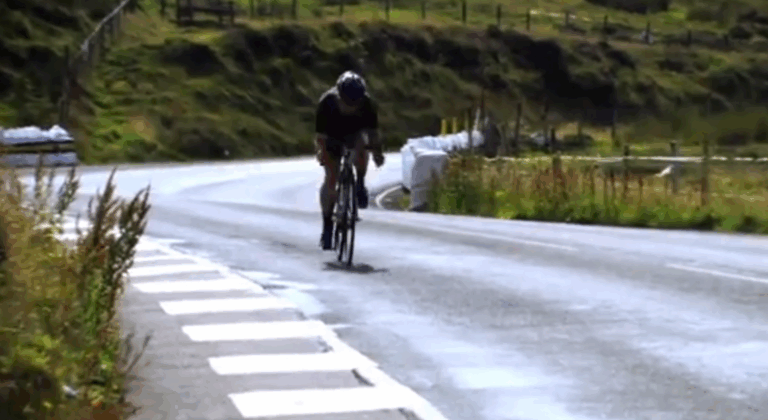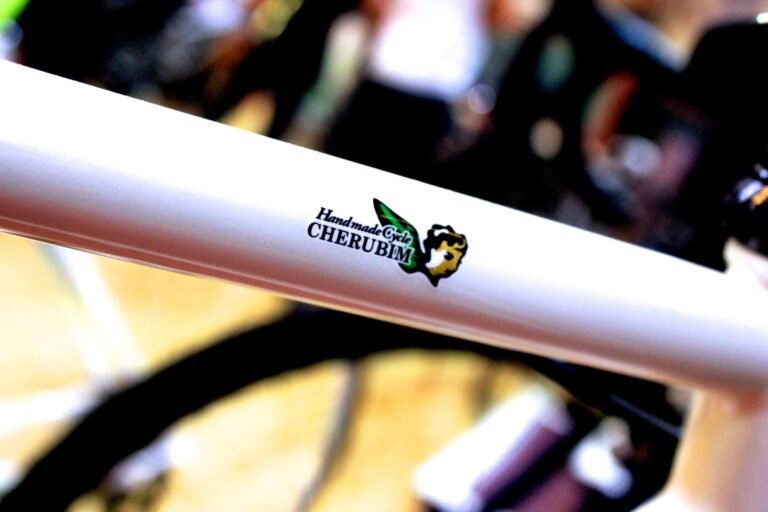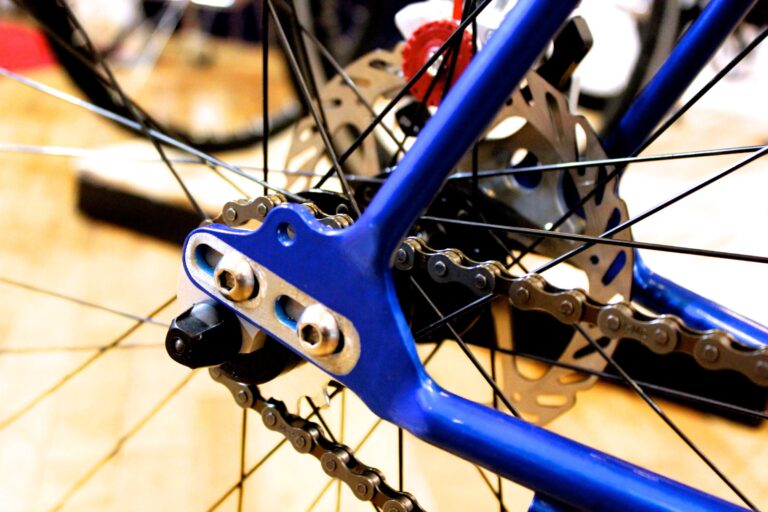We’ve made the annual pilgrimage to the Eurobike expo in Friedrichshafen, Germany, and the pre-show demo day gave us the chance to ride SRAM’s Red 22 groupset, complete with hydraulic disc brakes, for the first time.
The American firm’s new top-of-the-range group was fitted to a Specialized S-Works Roubaix SL4, though this model won’t be available in the UK. Instead, Specialized are offering the Roubaix SL4 Expert Disc with Shimano’s new, road-specific hydraulic disc brakes to UK riders. That’ll cost £4,500, while the S-Works frameset will be available for £2,600.
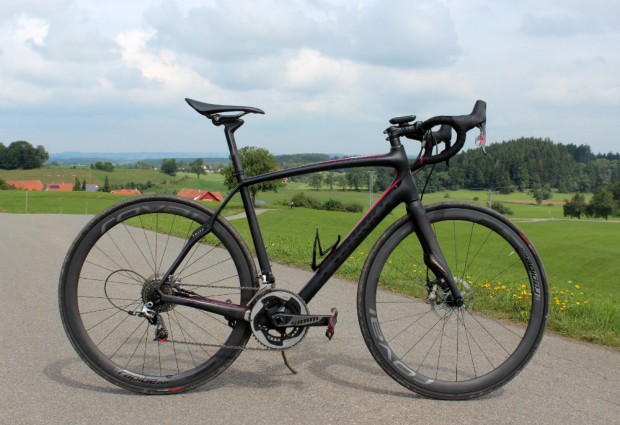
But we couldn’t pass up the opportunity to try Red 22 so, for now, the focus is on that – and we came away from our test ride impressed by the control and modulation offered by the American firm’s new hydraulic setup.
SRAM Red 22
The Roubaix seems the obvious platform for Specialized to introduce disc brakes into their road range. It’s a machine designed for demanding conditions and was ridden to victory at the race which gave the frame its name, Paris-Roubaix, in 2008, 2009, 2010 and 2012. With comfort high on the design agenda, the Roubaix is a model popular with sportive riders.
SRAM were the first of the big three groupset manufacturers to show their hand in regard to hydraulic disc brakes for road when they unveiled SRAM Red 22 in April. The group is available in three brake options: mechanical rim brakes, hydraulic rim brakes and hydraulic disc brakes.
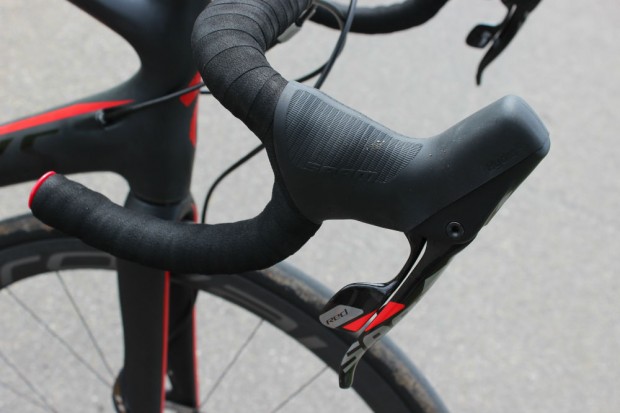
That final option is the most eagerly anticipated – and the one which has generated the most column inches.
First, a disclaimer: our hour-long test ride gave us a good chance to get to grips with the new group, and how it worked with the frame, but was by no means a conclusive test. We expect to test the new technology more extensively as model year 2014 bikes become available but our first ride did give us the chance to form some crucial first impressions.
Improved modulation, more control
And they are? In short, SRAM’s hydraulic disc brakes offer far greater modulation than traditional, mechanical rim brakes. On the road, that translates to far greater feel on the lever between the initial contact of the brake pads on the rotor, and the point at which you’re able to lock the back brake into a skid.
Apply pressure to the lever and you are rewarded with smooth, linear braking. That enables you, the rider, to control the power of braking to a far greater degree and it is very difficult to lock-up the back brake without applying a huge amount of force to the lever. The difference in modulation was keenly felt when switching back to mechanical rim brakes on subsequent test rides of the BMC Team Machine SLR01 and Scott Addict Team Issue (watch out for first ride reports on both).
Power is perhaps not the key selling point of disc brakes, particularly when the top-end mechanical brakes from SRAM Red, Shimano Dura-Ace and Campagnolo Super Record now offer such impressive stopping distances. Instead, manufacturers are keen to extoll the claimed virtues of improved modulation and wet weather performance.
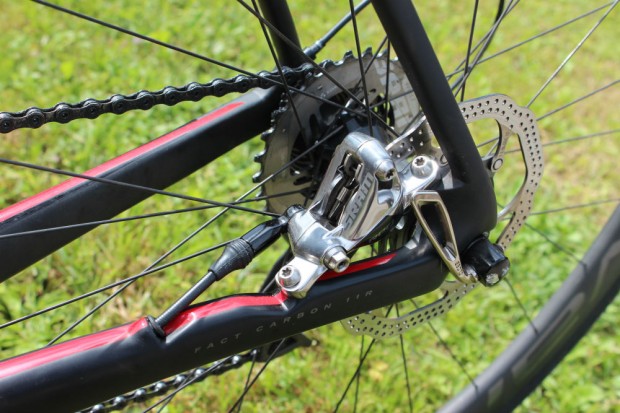
SRAM Red 22 seems to offer the former in spades but the latter is perhaps just important for UK riders. Rim brakes, particularly those used on a carbon braking track, typically suffer when ridden in the wet, while our experience of disc brakes on mountain bikes is that they offer consistent braking, regardless of conditions. Unfortunately our Red 22 test ride took place on dry tarmac so we weren’t able to see the benefits on the road for ourselves. File that one under ‘winter testing’, when disc brakes really could come into their own.
The brake hydraulics are housed in the new SRAM Hydro R lever, which, as a result, has a hood which is considerably taller than that we’re used to seeing. Even with disc brakes fitted front and rear, your eye is immediately drawn to the hood. Place your hands on the handlebar and they are dwarfed by the elongated profile – but it has little impact when riding.
The rest of the hood is as you’d expect from SRAM Red and it took only a few pedal strokes to forget the shape of the hood was any different to normal. Only when riding hard, forearms parallel to the road and hands draped over the top of the hood is it likely to produce a different experience. Otherwise, the ergonomics of the rest of the hood and lever are as you’d expect from SRAM.
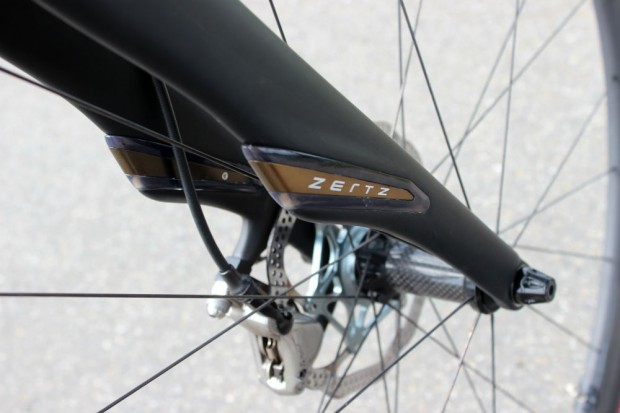
Our initial impressions are of a braking experience which offers a genuinely different experience to rim brakes but it’s important to note there are negatives to discs, as well as positives, not least service issues (hydraulic disc brakes require bleeding, and aren’t as easy to fix on the fly as a mechanical rim brake), extra weight and fork/wheel compatibility. The latter is likely to become less significant as more manufacturers come on board following the launch of SRAM and Shimano’s hydraulic systems.
Specialized Roubaix
Disc brakes aside, the Roubaix is essentially Specialized’s ‘comfort’ bike and all frames in the range now use the Morgan Hill-based company’s SL4 size-specific construction. This S-Works model uses a top-of-the-range carbon layup which Specialized call Fact Carbon 11r.
The Roubaix uses Zertz elastomer inserts on the fork and seatstays to boost comfort. The roads around Friedrichshafen are uniformly smooth, like riding on a billiard table, and so are not the best test of the Roubaix’s comfort. Any bike feels comfortable round here, but we took a detour off the official test route and sent the Roubaix down a gravel farm track, which in turn led to a short cobbled section.
The comfort offered by the rear of the frame on these sections was impressive, with any vibrations kicked up from the road into the frame significantly dampened before they reached the rider (the proprietary COBL GOBL-R seatpost also helped to nullify big hits when riding in the saddle), though the front end produced a harsher experience.
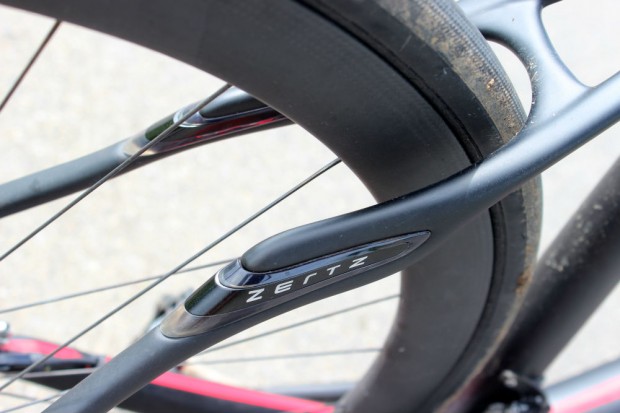
The rolling roads also provided a good early test of the Roubaix’s climbing ability and it felt stiff through the bottom bracket and chainstays, if not as punchy as lighter frames with oversized tube profiles like the BMC Team Machine SLR01 and Scott Addict Team Issue.
The Roubaix’s geometry is slightly more relaxed than the race-ready Tarmac and the 190mm headtube makes for a fairly high riding position, but the handling felt significantly sharper than many sportives bikes we’ve tried.
Otherwise, our machine was equipped with Specialized Roval Rapide CLX 40 full-carbon wheels, shod with the 26mm Turbo tyres, with Specialized finishing kit completing a bike, groupset aside, dressed head to toe in the firm’s components. That made for a decidedly high-end spec which undoubtedly contributed to performance. The 26mm tyres are worth noting: wider tyres are becoming increasingly popular for their improved grip and comfort, with little or no rolling resistance penalty, and the Turbo rubber felt both supple and grippy.
Are disc brakes the future?
The Roubaix has a significant history behind it, as one of the most popular sportive bikes on the market and thanks to its race race-winning pedigree at Paris-Roubaix.
Instead, it is disc brakes, and specifically SRAM’s setup here, which provide a glimpse into a future we are less familiar with.
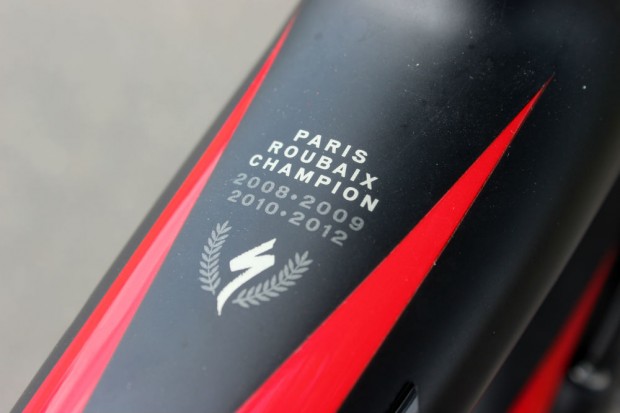
The technology is in its infancy and it’ll be some time before disc brakes are a realistic option for many but SRAM Red 22 and, crucially the S700 levers which can be retro-fitted to any other SRAM group, offers a very different braking experience in terms of control and modulation to what we’re used to on road bikes. We’re looking forward to a longer test – not least through a British winter – when we can see whether disc brakes are a genuine alternative to rim brakes.
With disc brakes unlikely to be permitted for use in road racing for some time by the UCI, the acceptance of disc brakes will be a decision led by consumers and manufacturers, rather than the need of professional riders. SRAM and Shimano’s hydraulic road groupsets give bike manufacturers a platform to dip their toe into the disc brake water. The next few days at Eurobike will give us a clue as to whether they have started to take that opportunity.
Website: Specialized



